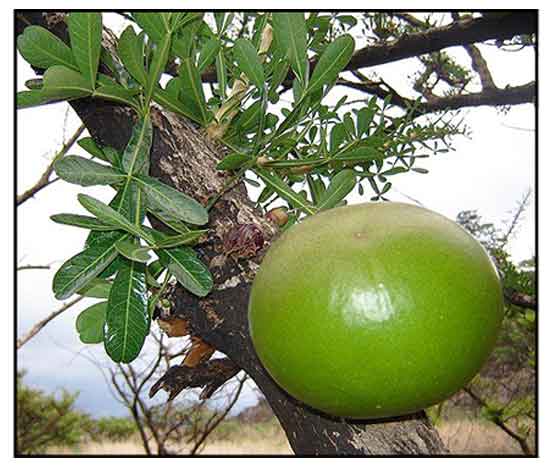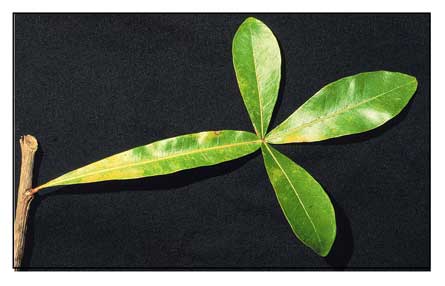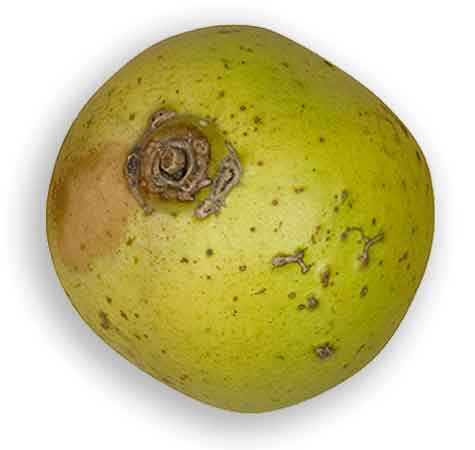 Gen info Gen info
- Crescentia alata is a plant species in the Bignoniaceae family and the genus Crescentia with its six species.
- It shares with Crescentia cujete, a closely related tree, the use "calabash" and "gourd" in their common names.
- Horses have been observed to smash the fruits with their hooves to eat the pulp and seeds, thus serving as seed distribution vectors.
- The local name "krus-krusan"
relates to the leaf rather than the fruit, with a flavor of Philippine religiosity referring to the striking appearance of the winged leaf-life stalk resembling a cross or crucifix.
Botany
Krus-krusan is a small tree, 3 to 6 meters high. Leaves occur in fascicles at the nodes of the branches. Leaves are striking in appearance, with its winged leaf-like stalk, about 1 centimeter wide, at the tip of which are three leaflets, shorter than the leaf-like petiole. Leaflets are broadest near the end, with a notched tip and a wedged-shaped base, 4 to 7 centimeters long, without individual stalks. Flowers are borne singly on the trunk, brownish and rank-scented. Calyx is split into two lobes, about 1.5 centimeters long. Corolla is somewhat bell-shaped, about 6 centimeters long, 4 centimeters wide, with 5 short lobes. Fruit is hard, rounded, and about 5 centimeters in diameter.
Distribution
- Introduced from Mexico during Spanish colonial times.
-
Occasionally cultivated for ornamental purposes in Rial and Quezon Provinces.
 Constituents Constituents
- Analysis of the pulp yielded: mineral salts, fixed oil 8%, resin, glucose, tannic acid, peptic principles, dextrine and cellulose.
- Study of fruit pulp of Crescent alata isolated four new 11-nor-iridoids, 6beta, 7beta, 8alpha,10-tetrahydroxy-cis-2-oxabicyclo[4.3.0]nonan-3-one (1), 6beta,7beta,8alpha,10-tetra-p-hydroxybenzoyl-cis-2-oxabicyclo[4.3.0]nonan-3-one (2), 1beta,6beta,7alpha,8alpha,10-pentahydroxy-cis-2-oxabicyclo[4.3.0]nonage (3), and 6beta-hydroxy-2-oxabicyclo[4.3.0]Delta8-9-nonen-1-one (4). (1)
 - Chemical evaluation of ensilaged fruit material
showed the meals to contain on average 17% crude fat, 11% crude fiber, and 18% crude protein. (3) - Chemical evaluation of ensilaged fruit material
showed the meals to contain on average 17% crude fat, 11% crude fiber, and 18% crude protein. (3)
- Studies have yielded flavorless
rutin, kaempferol 3-O-rutinoside, and kaempferol.
- Photochemical study of leaves and bark yielded three compounds from the bark:
a phenylpropanoid, 4-hydroxy-3-methoxybenzoic acid (vanillic acid); a triterpenoid, lupeol; and a flavonol glycoside, quercetin-3-rutinoside (rutin), and one compound from the leaves: a sterol, 24-ethyl-5,22-cholestadien-3-b-ol (stigmasterol). (see study below) (8)
- Fractionation of methanol extract yielded two flavonol glycosides: quercetin 3-O-alpha-L-rhamnopyranosyl-(1->6)-beta-D-glucopyranoside (rutin) (1), kaempferol 3-O-alpha-L-rhamnopyranosyl-(1->6)-beta-D-glucopyranoside (kaempferol 3-O-rutinoside) (2), and flavonol aglycone, kaempferol (3). (see study below) (9)
Properties
- Considered astringent, anti-hemorrhagic, pectoral.
- Studies have shown antimicrobial, antioxidant, insecticidal, anti-inflammatory, cytotoxicity properties.
Parts used
Leaves
 Uses Uses
Edibility
- Seeds are edible, high in protein, with a licorice-sweet taste. Used in Honduras, El Salvador and Nicaragua in making a chordata, Semilla de Jicaro. (4)
Folkloric
- Decoration of leaves employed as astringent and anti-hemorrhagic.
- Used for hemoptysis and dysentery.
- In Mexico, pulp taken internally as a pectoral and for diseases of the kidney.
- Pulp or decoction of leaves used for diarrhea.
-
Decoction also used for hair growth or to prevent it from falling.
- In Guatemala, used for inflammation, respiratory diseases, fever and weight loss.
Others
- Feed: Ground fruit pulp sometimes used as poultry feed supplement.
- Crafts: In Central America, it is cultivated for its gourd-like fruits, which are hallowed, dried, and painted into various artisanal handicrafts such as ornamental bowls, piggy banks, etc.
Studies
• Antimicrobial: Study of 18 crude extracts from six different plants evaluated for potential antimicrobial activity against S aureus, E.. faecalis, S pneumonia, S. pyogenes, E. coli and C. albicans. The extracts of G. oxyphyllum, G. americanum and Crescentia alata possessed strong antimicrobial activity against the pathogens tested. (2)
• Chemical Evaluation of Flours: Chemical evaluation of ensilaged fruit material material
showed the meals to contain on average 17% crude fat, 11% crude fiber, and 18% crude protein. The flours were limiting in the sulfur amino acid, lysine and thyronine content. (3)
 • Distribution Factors: Report hypothesizes that the distribution of Jivaro dramatically changed with the introduction of the horse. The pulp is eaten by horses, surrogate Pleistocene dispersal agents, and the seeds pass through to germinate in dung. Two samples of ripe fruits weighed an average of 210 and 390 g containing an average of 400 and 600 seeds. (6) • Distribution Factors: Report hypothesizes that the distribution of Jivaro dramatically changed with the introduction of the horse. The pulp is eaten by horses, surrogate Pleistocene dispersal agents, and the seeds pass through to germinate in dung. Two samples of ripe fruits weighed an average of 210 and 390 g containing an average of 400 and 600 seeds. (6)
• Bioinsecticidal / Larvae of Spodoptera frugiperda: Study evaluated the activity of Crescentia alata against Spodoptera frugiperda. Results showed bioinsecticidal activity. Possibly, the iridoids identified from C. alata fruit fractions are responsible for the antifeedant activity and mortality. (7)
• Antioxidant / Phytochemicals of Bark and Leaves: Phytochemical study of leaves and bark yielded one compound from the leaves, stigmasterol; and three compounds from the bark, vanillic acid, lupeol, and rutin. Screening of crude extracts and pure compounds showed antioxidant activity comparable to vitamin E. (see constituents above) (8)
• Anti-Inflammatory / Inhibition of Nitric Oxide Synthase: Study evaluated a methanol extract for in vivo anti-inflammatory activity on carrageen paw edema in rats and in vitro on Escherichia coil LS-induced NO production and iNOS expression in J774.A1 macrophage cell line. Results showed significant in vivo anti-inflammatory activity at highest dose tested. Same extract showed in vitro inhibitory activity on iNOS synthesis expression and NO formation in LS-primed J774.A1 cells. (see constituents above) (9)
• Physiochemical Characterization of Seeds: Jiaro cotyledons yielded 43.6 ± 1.15 g protein/100g and 38.0 ± 0.20 g/fat/100g (DW), comparable to most protein-rich and oleaginous seeds. Lipid analysis yielded 71.2% unsaturated fatty acids, particularly polemic acid. Essential amino acids represented 16.0 ± 0.9% (DW) of the protein fraction, similar to soybean amino acid content. Seed trypsin inhibitory activity was low (0.1 trypsin inhibitor units TIU/mg), which enhances digestibility of its proteins. The Jicaro seed is a novel biodiverse food crop rich in high quality oil and proteins, with a nutritional fatty acid and amino acid profile, with an absence of anti-nutritional factors. As food source, it is resistant to nutrient-poor soils and intense drought. (10)
• Bioinsecticidal / Spodoptera frugiperda / Fruits: Study evaluated the activity of Crescentia alata against Spodoptera frugiperda (fall armyworm). Results showed bioinsecticidal activity. Fractions 5 and 6 at 200, 100, and 50 ppd induced highest mortalities ranging from 65-80%. Iridoids from the fruit fractions were possibly responsible for the antifeedant activity and mortality or S. frugiperda. (11)
• Stigmasterol / Antimicrobial / Cytotoxicity / Leaves: Study evaluated the stigmasterol isolated from 80% methanol extract of leaves of C. alata using bio-guided fractionation and spectral analysis. The EA fraction afforded a bioactive compound stigmasterol. The isolated compound showed strongest antimicrobial effect against all microbial strains tested with MICs ranging from 1.95 to 125 µg/mL. Cytotoxicity study indicated the stigmasterol possessed much potential against Hela (mammalian cancer) cell line. (12)
Availability
Wild-crafted.
|

![]()






 Uses
Uses 
